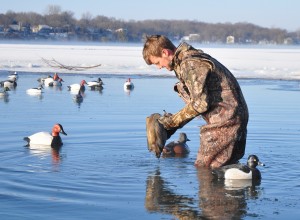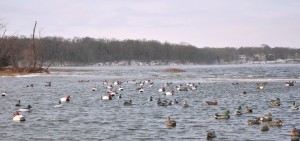Photography courtesy of Lowell Washburn, all rights reserved.
Even by Northern Plains standards, the season’s first winter storm was one for the record books. The massive weather system — officially dubbed Winter Storm Astro — roared onto the mid-western scene on Tuesday, November 11, delivering subzero wind chills and dumping more than a foot of snow on portions of Minnesota and Wisconsin. In Minnesota, the combination of high winds and icy roadways put more than 500 vehicles in the ditch. Forecasters predicted that before it was over, all 50 states would see freezing temperatures.
In Northern Iowa, temperatures continued to plunge steadily as northwest winds gusted to 40 mph. For area waterfowl hunters, Winter Storm Astro was a call to arms. Any ducks that still remained on northern Minnesota lakes were certain to stage a mass departure for the south.
By mid-morning, the migration had reached Iowa’s northern border as thousands upon thousands of southbound web-foots — redheads, scaup, ring-necks, canvasbacks, buffleheads, goldeneyes and others — began streaming into the state. For many hunters it was a dream come true as hundreds of ducks descended to the decoys. But it was also obvious that the dream wouldn’t last. This year’s November migration would be short and sweet. With nighttime temperatures barely hanging in the lower double digits, those area lakes and marshes still containing open water were sure to freeze over as soon as the winds slacked off.
Of all the hunters hoping to enjoy the spectacular migration, it is likely that few had traveled farther than Nashville, Tennessee’s Ben Anderson. A pastor at Christ Life Community Church, Anderson is also an avid waterfowl enthusiast who journeys to Northern Iowa each November for a few days of duck hunting. We get together for at least two or three of those hunts, and the outings are becoming a North Iowa tradition. Although an early freeze-up seemed eminent, Ben decided to make the trek anyway, hoping the migration would provide an opportunity to bag his first ever canvasback duck — a species long held in highest esteem by waterfowl hunters everywhere but rare in Tennessee.
Anderson joine the hunt during the storm’s second day. As raging winds and heavy intermittent snowsqualls intensified, flocks of late season scaup, ring-necks, mallards and goldeneyes continued to arrive. Then, at long last, a distant pair of canvasback ducks materialized above the whitecaps. At first it appeared as if the birds would pass us by. But at the last minute, the ducks spotted our spread and adjusted their course. Arriving over the decoys, the ‘cans hit the brakes and dropped the landing gear. Shouldering the gun, Anderson collected his first ever drake canvasback. Mission accomplished; we determined that bagging this single magnificent bird had made the long drive to Iowa well worth the effort. Whatever excitement might occur during the remainder of our hunt would certainly pale by comparison.
The polar, wind driven migration lasted for three consecutive days. Then, on November 14, the raging winds subsided and the last open waters began to rapidly ice over. Snowfalls continued and, for all practical purposes, this year’s duck migration had come to an abrupt and early conclusion. Although it triggered the most spectacular bird migration of the entire season, Winter Storm Astro provided a record that no one wanted to set.
LW





 Tom Cope
Tom Cope Sue Wilkinson
Sue Wilkinson Susan Judkins Josten
Susan Judkins Josten Rudi Roeslein
Rudi Roeslein Elyssa McFarland
Elyssa McFarland Mark Langgin
Mark Langgin Adam Janke
Adam Janke Joe Henry
Joe Henry Kristin Ashenbrenner
Kristin Ashenbrenner Joe Wilkinson
Joe Wilkinson Dr. Tammy Mildenstein
Dr. Tammy Mildenstein Sean McMahon
Sean McMahon